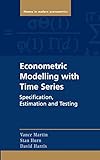Econometric modelling with time series : specification, estimation and testing / Vance Martin, University of Melbourne, Australia, Stan Hurn, Queensland University of Technology, Australia, David Harris, Monash University, Australia.
Series: Themes in modern econometricsPublisher: Cambridge, U. K. : Cambridge University Press, 2013Description: xxxv, 887 pages : illustrations ; 25 cmISBN:- 9780521196604 (hbk.)
- 9780521139816 (pbk.)
| Item type | Current library | Home library | Collection | Call number | Materials specified | Copy number | Status | Date due | Barcode | |
|---|---|---|---|---|---|---|---|---|---|---|
| AM | PERPUSTAKAAN TUN SERI LANANG | PERPUSTAKAAN TUN SERI LANANG KOLEKSI AM-P. TUN SERI LANANG (ARAS 5) | - | HB141.M377 (Browse shelf(Opens below)) | 1 | Available | 00002105923 |
Includes bibliographical references (pages 865-876) and indexes.
'This book provides a general framework for specifying, estimating, and testing time series econometric models'-- Provided by publisher.
'Maximum likelihood estimation is a general method for estimating the parameters of econometric models from observed data. The principle of maximum likelihood plays a central role in the exposition of this book, since a number of estimators used in econometrics can be derived within this framework. Examples include ordinary least squares, generalized least squares and full-information maximum likelihood. In deriving the maximum likelihood estimator, a key concept is the joint probability density function (pdf) of the observed random variables, yt. Maximum likelihood estimation requires that the following conditions are satisfied. (1) The form of the joint pdf of yt is known. (2) The specification of the moments of the joint pdf are known. (3) The joint pdf can be evaluated for all values of the parameters, 9. Parts ONE and TWO of this book deal with models in which all these conditions are satisfied. Part THREE investigates models in which these conditions are not satisfied and considers four important cases. First, if the distribution of yt is misspecified, resulting in both conditions 1 and 2 being violated, estimation is by quasi-maximum likelihood (Chapter 9). Second, if condition 1 is not satisfied, a generalized method of moments estimator (Chapter 10) is required. Third, if condition 2 is not satisfied, estimation relies on nonparametric methods (Chapter 11). Fourth, if condition 3 is violated, simulation-based estimation methods are used (Chapter 12). 1.2 Motivating Examples To highlight the role of probability distributions in maximum likelihood estimation, this section emphasizes the link between observed sample data and 4 The Maximum Likelihood Principle the probability distribution from which they are drawn'-- Provided by publisher.
There are no comments on this title.

